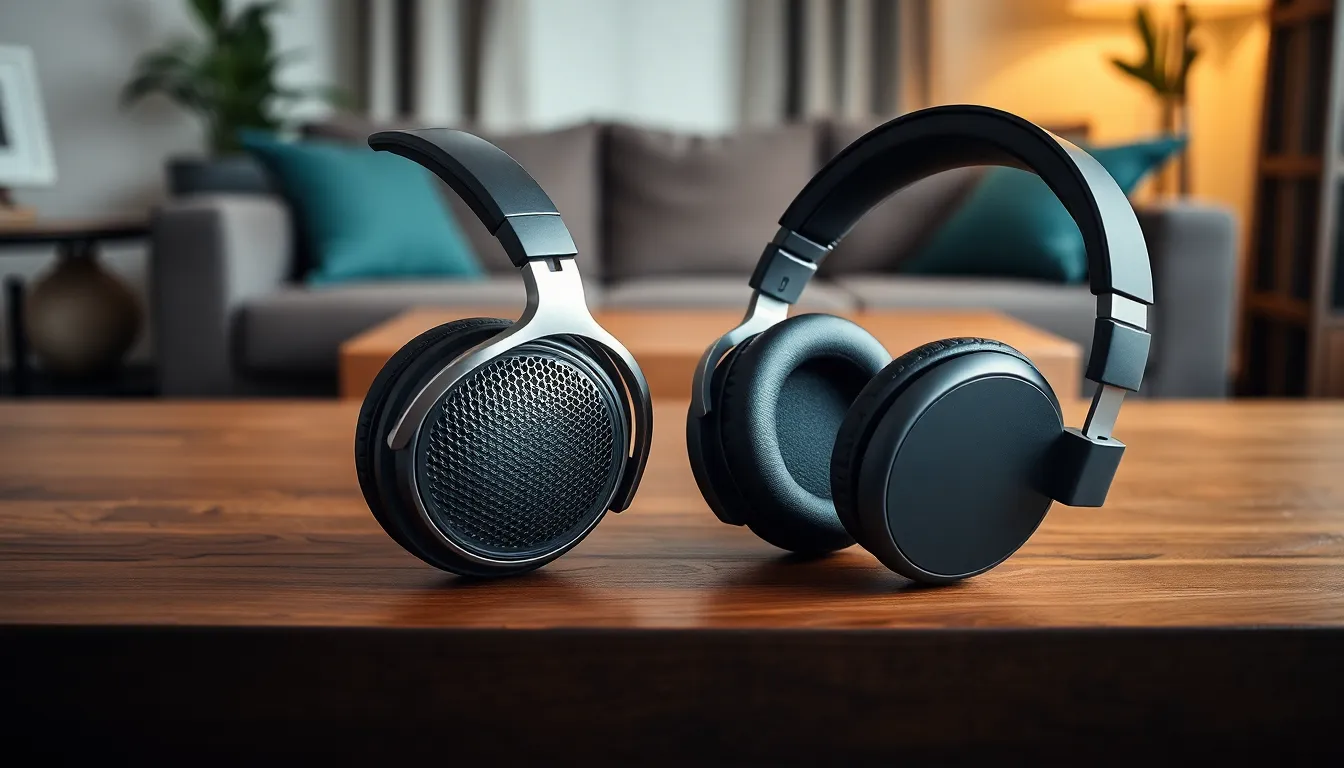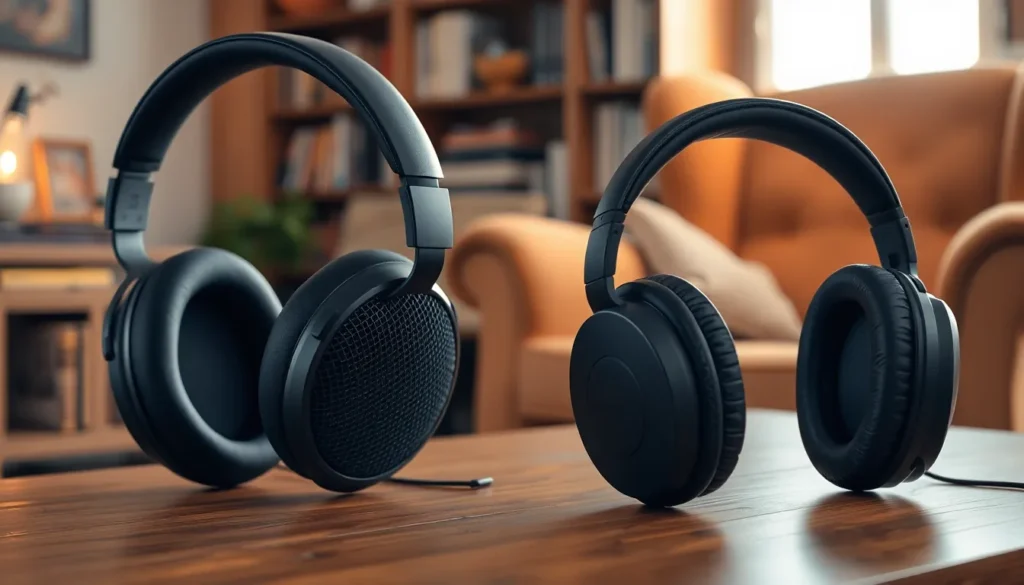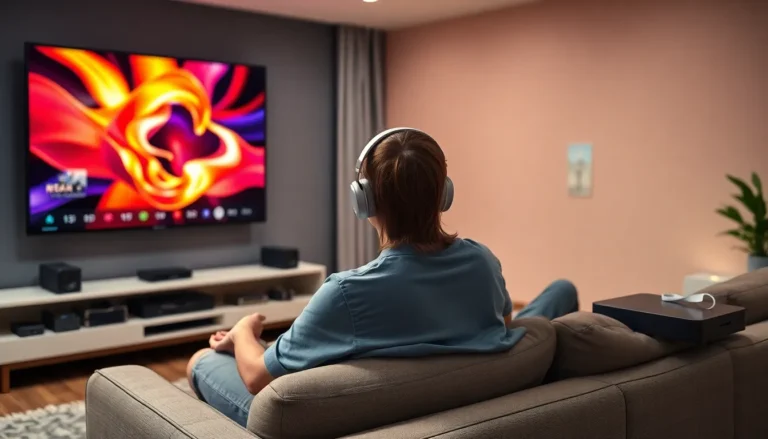When it comes to headphones, choosing between open-back and closed-back designs can feel like picking between pizza and tacos—both delicious but entirely different experiences. Open-back headphones let sound flow in and out, creating a more natural listening environment that feels like a live concert in your living room. On the flip side, closed-back headphones wrap your ears in a cozy sound cocoon, blocking out distractions and keeping your tunes all to yourself.
Each style has its loyal fans, and understanding the differences can elevate your audio game. Whether you’re a casual listener or an audiophile hunting for the perfect sound, knowing what suits your needs makes all the difference. So grab your favorite snack, settle in, and let’s dive into the world of open-back versus closed-back headphones. Who knew sound could be so much fun?
Table of Contents
ToggleOverview of Open-Back and Closed-Back
Open-back headphones feature designs that allow sound to flow freely through the ear cups. This design results in a more natural listening experience. Many users describe the sound as open and airy, similar to attending a live concert. These headphones excel in soundstage and imaging, providing an immersive auditory environment. However, they allow ambient noise to enter, which might not suit everyone.
Closed-back headphones, in contrast, block external sounds effectively. They create an isolated sound environment that minimizes distractions. Listeners appreciate the punchy bass response often produced by these headphones. Such headphones are ideal for studio use and noisier settings, where sound clarity remains essential. Their design helps retain sound within the ear cups, preventing sound leakage.
When comparing the two, usage scenarios play a crucial role. Open-back headphones suit home listening in quiet environments. Closed-back headphones cater to diverse situations, such as commuting or studio monitoring. Preferences vary among users; some prioritize natural sound, while others favor isolation.
Both headphone types serve unique purposes. Open-back designs enhance listening experiences, while closed-back models ensure focused listening. Understanding these characteristics helps individuals make informed choices tailored to their audio needs.
Sound Quality Comparisons

Sound quality plays a crucial role in differentiating open-back and closed-back headphones. Each style exhibits distinct characteristics in bass response and soundstage.
Bass Response
Bass response varies significantly between open-back and closed-back headphones. Closed-back headphones often deliver a punchier, more pronounced bass experience. This characteristic makes them well-suited for genres like hip-hop or electronic music, where deep bass is essential. Open-back headphones, however, tend to produce bass that’s less emphasized. While this can lead to a more balanced sound, it may lack the same intensity that some listeners prefer. Those seeking an immersive bass experience may gravitate toward closed-back options. Thus, the preferred headphone type depends largely on the listener’s music genre and personal taste.
Soundstage and Imaging
Soundstage and imaging represent critical factors in headphone performance. Open-back headphones excel in these areas, offering a wider and more natural soundstage. Sounds appear to emanate from various directions, creating an immersive listening experience akin to attending a live concert. This characteristic benefits genres like classical or jazz, where spatial considerations are vital. In contrast, closed-back headphones typically produce a more confined soundstage. This design allows for isolation, making them favorable for studio applications. However, some listeners may find the soundstage more limited compared to open-back options. The choice between these styles should align with the listener’s priorities, whether clarity and spaciousness or isolation and focus.
Comfort and Design Differences
Understanding comfort and design differences between open-back and closed-back headphones allows for better audio choices. Each headphone type incorporates unique characteristics that affect user experience.
Ear Cup Materials
Open-back headphones typically use lighter materials for ear cups, which promotes airflow and enhances comfort during extended listening. They often feature mesh or fabric designs that keep the ears cool and mitigate sweat buildup. Closed-back headphones, on the other hand, employ denser materials, like plastic or leather, to create an effective sound isolation environment. This design choice increases weight, but it helps block outside noise. Users often prefer soft padding on ear cups, enhancing comfort for longer sessions.
Weight and Fit
Weight significantly impacts the comfort level of headphones. Open-back headphones often weigh less due to lighter materials, allowing for extended wear without discomfort. Fit varies with each design, as open-back models typically feature wider ear cups, which accommodate larger ears comfortably. Closed-back headphones are generally more snug, ensuring a secure fit that effectively blocks ambient noise. Finding the right fit is crucial, especially for those using headphones for long periods.
Use Cases for Each Type
Understanding the optimal use cases for open-back and closed-back headphones enhances audio experiences.
Optimal Situations for Open-Back
Open-back headphones fit perfectly in quiet environments. They excel in home listening situations where ambient noise is minimal. Audiophiles appreciate their natural sound, as these headphones provide an expansive soundstage. Live recordings and classical music benefit greatly from the clarity these headphones offer. Listeners seeking an immersive experience find enjoyment in genres like jazz or acoustic music. Open-back models are great for long listening sessions due to their breathable design that keeps the ears cool.
Best Scenarios for Closed-Back
Closed-back headphones shine in noisy environments. Commuting or traveling is ideal for their sound isolation properties. Musicians and sound engineers favor them in studio settings, as they minimize sound leakage during recordings. Their bass response suits genres such as hip-hop or electronic music, appealing to those who enjoy impactful sound. These headphones provide comfort with a snug fit, ensuring that distractions are kept at bay. Listeners prioritizing portability find closed-back models advantageous for on-the-go use.
Price Range and Value
Price ranges vary significantly between open-back and closed-back headphones, reflecting their designed purpose and features. Open-back models typically range from $100 to $1,200, offering a wide selection for audiophiles desiring expansive soundscapes. Brand reputation plays a role, with high-end options delivering superior sound quality and build materials.
Closed-back headphones often fall between $50 and $600, making them accessible to casual listeners and professionals alike. Budget models still provide solid isolation and durability, suitable for everyday use. As the price increases, enhancements in sound quality and comfort become noticeable, especially for genres requiring bass emphasis.
Buying choices frequently hinge on how much emphasis users place on sound isolation versus soundstage. Open-back headphones excel in creating an airy listening experience but may not suit environments with ambient noise. Conversely, closed-back headphones deliver impressive bass without compromising isolation.
Value perceptions fluctuate based on personal priorities. For example, if immersive sound is crucial, higher-priced open-back headphones may justify their cost. If sound isolation matters more, investing in premium closed-back models could yield better satisfaction.
Overall, understanding the price range associated with each type helps consumers make informed decisions tailored to their listening environment. Evaluating how much one is willing to spend on sound quality, comfort, and design can lead to an ideal headphone choice.
Choosing between open-back and closed-back headphones ultimately depends on individual preferences and listening environments. Open-back models shine in quiet spaces where soundstage and clarity are paramount. They create an immersive experience ideal for genres that benefit from nuanced details.
On the other hand closed-back headphones excel in noisy settings where sound isolation is essential. Their robust bass response caters to listeners who enjoy more energetic music styles.
By understanding these distinctions listeners can make informed decisions that enhance their audio experiences. Whether it’s the airy sound of open-backs or the impactful isolation of closed-backs each type offers unique benefits tailored to specific needs.






